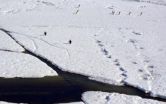(Press-News.org) A 70 million year old fossil found in the Late Cretaceous sediments of Alaska reveals a new small tyrannosaur, according to a paper published in the open-access journal PLOS ONE on March 12, 2014 by co-authors Anthony Fiorillo and Ronald S. Tykoski from Perot Museum of Nature and Science, Texas, and colleagues.
Tyrannosaurs, the lineage of carnivorous theropod ("beast feet") dinosaurs that include T. rex, have captivated our attention, but the majority of our knowledge about this group comes from fossils from low- to mid-latitudes of North America and Asia. In this study, scientists analyzed the partial skull roof, maxilla, and jaw, recovered from Prince Creek Formation in Northern Alaska, of a dinosaur originally believed to belong to a different species, and then compared the fossils to known tyrannosaurine species.
According to the results of the authors' analysis, the cranial bones represent Nanuqsaurus hoglundi, a new tyrannosaurine species closely related to two other tyrannosaurides, Tarbosaurus and Tyrannosaurus. This new dinosaur is estimated to be relatively small, with an adult skull length estimated at 25 inches, compared to 60 inches for T. rex. The new species likely inhabited a seasonally extreme, high-latitude continental environment on the northernmost edge of Cretaceous North America. The authors suggest that the smaller body size of N. hoglundi compared to most tyrannosaurids from lower latitudes may reflect an adaptation to variability in resources in the arctic seasons. Further diversification may stem from the dinosaurs' partial isolation in the north by land barriers, such as the east-west running Brooks Range. Although the preserved elements of N. hoglundi are fragments, the authors point to morphological data to provide support for its place among derived tyrannosaurines. This discovery may provide new insights into the adaptability and evolution of tyrannosaurs in a different environment, the Arctic.
"The 'pygmy tyrannosaur' alone is really cool because it tells us something about what the environment was like in the ancient Arctic," said Fiorillo. "But what makes this discovery even more exciting is that Nanuqsaurus hoglundi also tells us about the biological richness of the ancient polar world during a time when the Earth was very warm compared to today."
INFORMATION:
Citation: Fiorillo AR, Tykoski RS (2014) A Diminutive New Tyrannosaur from the Top of the World. PLoS ONE 9(3): e91287. doi:10.1371/journal.pone.0091287
Financial Disclosure: The National Science Foundation Office of Polar Programs provided funding for this work (OPP 0424594). The funders had no role in study design, data collection and analysis, decision to publish, or preparation of the manuscript.
Competing Interest Statement: The authors have declared that no competing interests exist.
PLEASE LINK TO THE SCIENTIFIC ARTICLE IN ONLINE VERSIONS OF YOUR REPORT (URL goes live after the embargo ends): http://dx.plos.org/10.1371/journal.pone.0091287
Dinosaur skull may reveal T. rex's smaller cousin from the north
70-million-year-old Alaskan dinosaur bones reveal smaller tyrannosaur
2014-03-12
ELSE PRESS RELEASES FROM THIS DATE:
Doctors issue new treatment guidelines for skin abscesses caused by MRSA
2014-03-12
It has been more than 10 years since the clinical battle began with community-acquired methicillin-resistant Staphylococcus aureus (MRSA), and doctors are still grappling with how to diagnose, treat and prevent this virulent form of staph infection, which is immune to many antibiotics.
As MRSA cases have increased dramatically over the decade, so have the number of skin abscesses — generally pus-filled boils or pimples with discharge — that characterize these infections. Now, researchers from UCLA have issued updated guidelines outlining the best ways to treat and manage ...
Facebook feelings are contagious
2014-03-12
You can't catch a cold from a friend online. But can you catch a mood? It would seem so, according to new research from the University of California, San Diego.
Published in PLOS ONE, the study analyzes over a billion anonymized status updates among more than 100 million users of Facebook in the United States. Positive posts beget positive posts, the study finds, and negative posts beget negative ones, with the positive posts being more influential, or more contagious.
"Our study suggests that people are not just choosing other people like themselves to associate with ...
Meta-analysis: Any blood pressure reading above normal may increase risk of stroke
2014-03-12
MINNEAPOLIS – Anyone with blood pressure that's higher than the optimal 120/80 mmHg may be more likely to have a stroke, according to a new meta-analysis published in the March 12, 2014, online issue of Neurology®, the medical journal of the American Academy of Neurology.
The meta-analysis looked at all of the available research on the risk of developing stroke in people with "prehypertension," or blood pressure higher than optimal but lower than the threshold to be diagnosed with high blood pressure, which is 140/90 mmHg. A total of 19 prospective cohort studies with ...
Gestational diabetes may raise risk for heart disease in midlife
2014-03-12
Pregnant women may face an increased risk of early heart disease when they develop gestational diabetes, according to research in the Journal of the American Heart Association.
Gestational diabetes, which develops only during pregnancy and usually disappears after the pregnancy, increases the risk that the mother will develop diabetes later. The condition is managed with meal planning, activity and sometimes insulin or other medications.
In the 20-year study, researchers found that a history of gestational diabetes may be a risk factor for early atherosclerosis in women ...
Nicotine withdrawal weakens brain connections tied to self-control over cigarette cravings
2014-03-12
PHILADELPHIA— People who try to quit smoking often say that kicking the habit makes the voice inside telling them to light up even louder, but why people succumb to those cravings so often has never been fully understood. Now, a new brain imaging study in this week's JAMA Psychiatry from scientists in Penn Medicine and the National Institute on Drug Abuse (NIDA) Intramural Research Program shows how smokers suffering from nicotine withdrawal may have more trouble shifting from a key brain network—known as default mode, when people are in a so-called "introspective" or ...
Gestational diabetes linked to increased risk for heart disease in midlife
2014-03-12
OAKLAND, Calif. — Women who experience gestational diabetes may face an increased risk of early heart disease later in life, even if they do not develop type 2 diabetes or metabolic syndrome subsequent to their pregnancy, according to a Kaiser Permanente study published today in the Journal of the American Heart Association.
"Our research shows that just having a history of gestational diabetes elevates a woman's risk of developing early atherosclerosis before she develops type 2 diabetes or metabolic syndrome," said Erica P. Gunderson, PhD, MPH, study lead author and ...
MU study suggests new rehabilitation methods for amputees and stroke patients
2014-03-12
COLUMBIA, Mo. – When use of a dominant hand is lost by amputation or stroke, a patient is forced to compensate by using the nondominant hand exclusively for precision tasks like writing or drawing. Presently, the behavioral and neurological effects of chronic, forced use of the nondominant hand are largely understudied and unknown. Now, researchers at the University of Missouri have shed light on ways in which a patient compensates when losing a dominant hand and suggest new and improved rehabilitation techniques for those suffering from amputation or stroke.
"Half of ...
Stem cells inside sutures could improve healing in Achilles tendon injuries
2014-03-12
Los Angeles, CA (March 12, 2014) Researchers have found that sutures embedded with stem cells led to quicker and stronger healing of Achilles tendon tears than traditional sutures, according to a new study published in the March 2014 issue of Foot & Ankle International (published by SAGE).
Achilles tendon injuries are common for professional, collegiate and recreational athletes. These injuries are often treated surgically to reattach or repair the tendon if it has been torn. Patients have to keep their legs immobilized for a while after surgery before beginning their ...
Computer model predicts vastly different ecosystem in Antarctica's Ross Sea in the coming century
2014-03-12
The Ross Sea, a major, biologically productive Antarctic ecosystem, "clearly will be extensively modified by future climate change" in the coming decades as rising temperatures and changing wind patterns create longer periods of ice-free open water, affecting the life cycles of both predators and prey, according to a paper published by researchers funded by the National Science Foundation (NSF).
To make their predictions, the researchers used information drawn from the Regional Ocean Modeling System, a computer model of sea-ice, ocean, atmosphere and ice-shelf interactions. ...
NASA sees ex-Tropical Cyclone Gillian in Australia's Gulf of Carpentaria
2014-03-12
Tropical Cyclone Gillian made landfall on the western Cape York Peninsula of Queensland, Australia, weakened and has now meandered back over water. On March 12, NASA-NOAA's Suomi NPP satellite captured an image of the remnants in the southern Gulf of Carpentaria.
On March 12 at 0600 UTC/2 a.m. EST, the remnants of Tropical Cyclone Gillian were located near 16.0 south and 141.1 east, about 115 nautical miles/ 132.3 miles/213 km east-northeast of Mornington Island in the Gulf of Carpentaria. According to the Joint Typhoon Warning Center or JTWC maximum sustained surface ...
LAST 30 PRESS RELEASES:
Tracing the quick synthesis of an industrially important catalyst
New software sheds light on cancer’s hidden genetic networks
UT Health San Antonio awarded $3 million in CPRIT grants to bolster cancer research and prevention efforts in South Texas
Third symposium spotlights global challenge of new contaminants in China’s fight against pollution
From straw to soil harmony: International team reveals how biochar supercharges carbon-smart farming
Myeloma: How AI is redrawing the map of cancer care
Manhattan E. Charurat, Ph.D., MHS invested as the Homer and Martha Gudelsky Distinguished Professor in Medicine at the University of Maryland School of Medicine
Insilico Medicine’s Pharma.AI Q4 Winter Launch Recap: Revolutionizing drug discovery with cutting-edge AI innovations, accelerating the path to pharmaceutical superintelligence
Nanoplastics have diet-dependent impacts on digestive system health
Brain neuron death occurs throughout life and increases with age, a natural human protein drug may halt neuron death in Alzheimer’s disease
SPIE and CLP announce the recipients of the 2025 Advanced Photonics Young Innovator Award
Lessons from the Caldor Fire’s Christmas Valley ‘Miracle’
Ant societies rose by trading individual protection for collective power
Research reveals how ancient viral DNA shapes early embryonic development
A molecular gatekeeper that controls protein synthesis
New ‘cloaking device’ concept to shield sensitive tech from magnetic fields
Researchers show impact of mountain building and climate change on alpine biodiversity
Study models the transition from Neanderthals to modern humans in Europe
University of Phoenix College of Doctoral Studies releases white paper on AI-driven skilling to reduce burnout and restore worker autonomy
AIs fail at the game of visual “telephone”
The levers for a sustainable food system
Potential changes in US homelessness by ending federal support for housing first programs
Vulnerability of large language models to prompt injection when providing medical advice
Researchers develop new system for high-energy-density, long-life, multi-electron transfer bromine-based flow batteries
Ending federal support for housing first programs could increase U.S. homelessness by 5% in one year, new JAMA study finds
New research uncovers molecular ‘safety switch’ shielding cancers from immune attack
Bacteria resisting viral infection can still sink carbon to ocean floor
Younger biological age may increase depression risk in older women during COVID-19
Bharat Innovates 2026 National Basecamp Showcases India’s Most Promising Deep-Tech Ventures
Here’s what determines whether your income level rises or falls
[Press-News.org] Dinosaur skull may reveal T. rex's smaller cousin from the north70-million-year-old Alaskan dinosaur bones reveal smaller tyrannosaur




